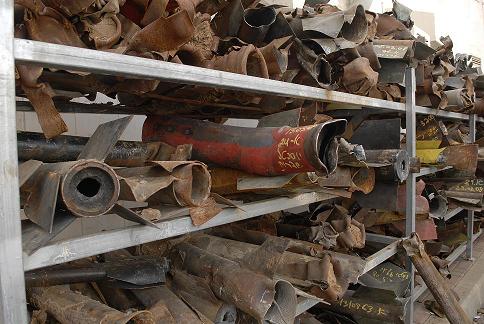How Israel copes with rockets
Note: This is the second in a 3-part series that examines how Israel’s security forces have developed some of the most effective counter-terrorism measures in the world. Last week, we looked at how the police and military forces form several layers around population centers, and respond swiftly to contain attacks. This week, we examine defensive and offensive responses to the ongoing threat of Palestinian rockets.
Introduction
In October 2001, Palestinian terrorists in Gaza fired the first rocket at Israel, striking the border town of Sderot. Few people imagined then that well over 10,000 rockets would be fired throughout the following decade, and that the rocket ranges would continue to increase, until major cities like Ashdod would be routinely attacked with rockets. (i)
In 2005, Israel withdrew from Gaza, marking a point in time from which rocket attacks grew dramatically in scope and frequency. In 2007, Hamas threw Fatah out of power in Gaza, and formed a radical Islamist ruling regime. The following year, a peak number of rockets and mortars were fired into Israel from Gaza – 3,276. Since 2005, well over 6,000 rockets were fired at southern Israel.
With time, the rockets are growing increasingly powerful and destructive, though so far most have not been fatal. In addition to the 25 casualties and hundreds of injuries they’ve caused, the attacks have led thousands of civilians, including children, to suffer from post-traumatic stress disorder (PTSD). There are an estimated 4,000 sufferers of PTSD in the town of Sderot alone. (ii) The projectiles have caused heavy damage to residential areas. They are often packed with deadly metal ball bearings, which act like machinegun bullets upon impact, spraying everything around them and piercing walls.
Rocket types:
| Type | Diameter | Warhead | Range |
| Qassam 2. | 105 millimeter | 5-7 kilograms of explosives | 8 – 10 kilometers |
| Qassam 3. | 107 millimeter | 10 kilograms of explosives | 10 kilometers |
| Grad. | 107 millimeter | 1.2 kilograms of explosives | 30 kilometers |
| Grad 2* | 122 millimeter | 6.3 kilograms of explosives | 40 kilometers |
| Fajr: Iranian missile | 240 millimeters | 45 kilograms of explosives | Range: 50 – 60 kilometers |
Hamas has also tested out new types of long-range rockets that can hit Tel Aviv.
*This rocket was made in China and smuggled into Gaza by Iran.
Israeli Responses: There are 3 main Israeli responses to this threat; Offensive, active defensive and passive defensive.
Offensive: Israel has a wide range of tools at its disposals to strike at rocket-launching crews on the ground, or elements higher up in the chain of command of organizations responsible for the attacks.
Israel relies primarily on the Israel Air Force to neutralize and respond to rocket threats in an offensive manner. Cobra attack helicopters, F-15 and F-16 fighter jets, and drones with missile payloads are all in service to strike targets in Gaza associated with rocket fire.
The Israel Air Force often works in conjunction with the Israel Security Agency (Shin Bet), which gathers intelligence on key targets on the ground. Targets include the rocket launchers, their vehicle, and rocket storage facilities, often hidden around schools, hospitals, and other civilian centers, as part of Hamas’s policy of using its population as human shields. (iii)
During times of intense rocket fire, as seen at the end of 2008, ground forces made up of special forces, infantry, armored vehicles, and tanks can be used to enter Gaza by land and seize territory to prevent it from being used to fire additional rockets.
Active defense: In recent months, Israel unveiled three operational batteries of the revolutionary Iron Dome rocket defense system. The product of years of research and development, this system uses complex radars to track the paths of incoming rockets, and fires its own missiles at the threat, neutralizing it in midair. Three more batteries are set to become operational in 2012.
The Iron Dome is not designed to be a solution to rockets, but rather, is part of an integrative defensive-offensive response, which offers protection to civilians and allows military and political leaders more time to reach important decisions during times of escalation.
Passive defense: Israel has invested heavily in passive defense techniques against the rockets. Three main bodies oversee this type of response: The IDF Home Front Command, the Israel Police, and the Public Security Ministry.
According to figures from the Home Front Command, 90 percent of Israeli civilians killed or injured during the 2006 Second Lebanon War and the 2008/9 Operation Cast Lead in Gaza were people struck by projectiles in open areas, away from buildings. (iv) Civilians who seek cover in designated safe zones during rocket attacks are extremely unlikely to be injured or killed.
For that reason, the Home Front Command has invested heavily in TV, radio, internet and newspaper ad campaigns to raise awareness among Israelis on how to choose a safe zone ahead of time.
Air raid sirens usually give civilians just enough time to seek cover before projectiles fall. Alerts are also changing with technology; the Home Front Command introduced a new system in recent years that sends text message alerts to cell phones belonging to people in targeted areas.
Once a year, the Home Front Command holds an exercise to get civilians used to responding to sirens and finding cover. Around 50% of the public chooses to take part.
During times of conflict, the Home Front Command also dispatches officers called Local Communication Units to regions heavily affected by rockets. (v) The officers use an internet-based communication system to send live feeds from the area to the Home Front Command’s control center.
The Israeli government is investing hundreds of millions of shekels to reinforce homes and public buildings in frontline communities against rockets.
For its part, Israel Police has a pivotal role in responding to rockets. Once a projectile lands in Israeli territory, it is the police that has supreme jusrisdiction over the scene of the attack.
Specially-trained bomb squad officers arrive to seal off the area, ensure that the explosives in the rocket are neutralized, and safely remove the threat.
Police oversee paramedics and firefighters who are called to rocket scenes if needed.
In November, the Public Security Ministry launched a 2.5-million-shekel emergency control room designed to provide decision-makers with real-time information during times of war. The center receives live feeds from all the emergency services, and from the IDF Home Front Command. (vi)
(i) Ashdod: Rockets from Gaza leave 1 seriously injured, Jerusalem Post August 19, 2011
(ii) Fear has no scent or sound, but it has a color: ‘Red’, Jerusalem Post August 26, 2011
(iii) IDF releases Cast Lead casualty numbers, Jerusalem Post March 26, 2009
(iv) Cellphone alert system expected in 2 years, Jerusalem Post November 8, 2009
(v) Awareness campaigns necessary to prepare nation for war, says IDF’s Home Front Command, Jerusalem Post December 27, 2009
(vi) Public Security Ministry opens new control center, Jerusalem Post November 29, 2011
Yaakov Lappin is author of the recently published book Virtual Caliphate; Exposing the Islamist State on the Internet, which takes the reader into the heart of the online jihadi presence. The book is available here.
www.amazon.com












I just came across this while chieckng out the WordPress theme, but just wanted to add:- During the truce’, which Israel observed, Palestinians have lobbed over 1,700 rockets into Israel in fact, there have been more rockets and mortars thrown into Israel during the truce then without it so this isn’t a question of One or two rockets thrown over from Gaza’.- of the 385 (now, over 400) casualties on the Palestinian side, only’ 60 or so have been civilians. Israel *does* have the technology for near surgical strikes, and they target either Hamas installations, weapons depots, infrastructure, or personnel.- Hamas deliberately uses civilian installations, like schools and mosques, to house their weapons, equipment, or personnel. This contributes as to why there are civilian casualties, as they use civilians as shields.- Israel, before targeting any buildings or locations that contain civilians, or have civilians nearby, alert and notify the civilians to clear the target zone. This is done either with flyers, or in some cases by making phone calls to the individuals advising to clear the premises. They are usually given 15 minutes or more to do so, which is plenty.- For the record, in contrast, Hamas targets civilians targets exclusively, with the intention of maximizing civilians casualties.There just seems to be a one-sided reporting on this issue, so I just wanted to throw in some factoids to balance this out.Thus, considering the above, and that we are not dealing with one or two rockets, at which point *DO* you decide that you have had enough shelling of your backyard, and are you allowed to do something about it?Think about that.